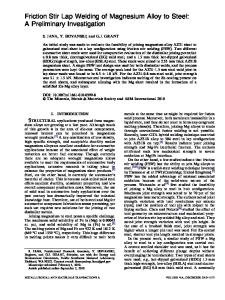Residual Stresses and Tensile Properties of Friction Stir Welded AZ31B-H24 Magnesium Alloy in Lap Configuration
- PDF / 7,829,058 Bytes
- 12 Pages / 593.972 x 792 pts Page_size
- 108 Downloads / 336 Views
TRODUCTION
SAVING energy has recently become a high priority globally for manufacturers. In particular, rising fuel costs have driven energy conservation efforts to improve the efficiency of all modes of transportation.[1] As such, there has been an increasing demand for lightweight materials in the transportation sector.[2,3] For instance, magnesium alloys have been considered for potential applications in the automotive and aircraft industries owing to their low density and high specific strength.[4–6] Therefore, the joining of magnesium alloys or their dissimilar combinations with other materials is essential for enabling the cost-effective manufacturing of complex parts and structures. However, the major technical challenge for the wide-spread use of magnesium alloys in structural applications is the ability to reliably produce high-quality joints. Specifically, the difficulties for these BHUKYA SRINIVASA NAIK, Ph.D. Candidate, JACOB FRIEDMAN, Professor and Chair, and DAOLUN CHEN, Professor, are with the Department of Mechanical and Industrial Engineering, Ryerson University, 350 Victoria Street, Toronto, ON M5B 2K3, Canada. Contact e-mail: [email protected] XINJIN CAO, Senior Research Officer, Adjunct Professor, is with the Department of Mechanical and Industrial Engineering, Ryerson University, and also with the Structures, Materials and Manufacturing Laboratory, National Research Council Canada - Aerospace, 5145 Decelles Avenue, Montreal, QC H3T 2B2, Canada. Contact e-mail: xinjin.cao@ cnrc-nrc.gc.ca PRITI WANJARA, Team Leader, is with the Structures, Materials and Manufacturing Laboratory, National Research Council Canada - Aerospace. The following statement pertains only to authors X. Cao and P. Wanjara: Published with permission of the Crown in Right of Canada, i.e., the Government of Canada. Manuscript submitted December 11, 2014. METALLURGICAL AND MATERIALS TRANSACTIONS B
alloys are mainly associated with oxidization, high thermal conductivity, high coefficient of thermal expansion, solidification shrinkage, and high solubility of hydrogen in the molten state. For dissimilar metal combinations, galvanic coupling and high corrosion potential can also be a deterrent for applications in vehicle structures. Recently, it was reported that similar magnesium alloy joints with high structural integrity can be obtained using solid-state joining techniques such as ultrasonic welding, friction stir welding (FSW), friction stir spot welding, and resistance spot welding.[7,8] Also, the processing, structure, performance, and applicability of the FSW process were investigated in detail for some similar and dissimilar magnesium alloys in different joint configurations, including butt[8–11] and lap.[4,12,13] To date, however, the mechanical performance reported in the literature has mainly focused on the room temperature (RT) tensile properties.[14–17] Little has been reported on the tensile properties of the friction stir welded (FSWed) AZ31B-H24 Mg alloy lap joints tested at low (LT) and elevated (ET) temperatures, which is importan
Data Loading...











